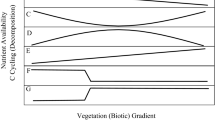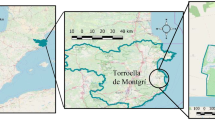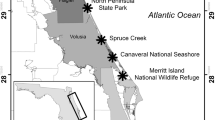Abstract
Saltmarshes provide many valuable ecosystem services including storage of a large amount of ‘blue carbon’ within their soils. To date, up to 50% of the world’s saltmarshes have been lost or severely degraded primarily due to a variety of anthropogenic pressures. Previous efforts have aimed to restore saltmarshes and their ecosystem functions, but the success of these efforts is rarely evaluated. To fill this gap, we used a range of metrics, including organic carbon stocks, root production, soil respiration and microbial communities to compare natural and a 20-year restoration effort in saltmarsh habitats within the Sydney Olympic Park in New South Wales, Australia. We addressed four main questions: (1) Have above- and belowground plant biomass recovered to natural levels? (2) Have organic carbon stocks of soils recovered? (3) Are microbial communities similar between natural and regenerated saltmarshes? and (4) Are microbial communities at both habitats associated to ecosystem characteristics? For both soil organic carbon stocks and belowground biomass, we found no significant differences between natural and regenerated habitats (F(1,14) = 0.47, p = 0.5; F(1,42) = 0.08, p = 0.76). Aboveground biomass was higher in the natural habitat compared to the regenerated habitat (F(1,20) = 27.3, p < 0.0001), which may result from a site-specific effect: protection from erosion offered by a fringing mangrove forest in the natural habitat but not the regenerated habitat. Our microbial community assessment indicated that restored and natural saltmarsh habitats were similar at a phylum level, with the exception of a higher proportion of Proteobacteria in the rhizosphere of saltmarshes from the regenerated habitat (p < 0.01). Abundance of both Desulfuromonas and Geobacter was associated with high carbon and nitrogen densities in soils indicating that these genera may be key for the recovery of ecosystem characteristics in saltmarshes. Our restored and natural saltmarsh soils store at 30 cm depth similar levels of organic carbon: 47.9 Mg OC ha−1 to 64.6 Mg OC ha−1. Conservation of urban saltmarshes could be important for ‘blue carbon’ programmes aimed at mitigating atmospheric carbon dioxide.







Similar content being viewed by others
References
Adam P. 2002. Saltmarshes in a time of change. Environ Conserv 29:39–61.
Adame MF, Wright SF, Grinham A, Lobb K, Reymond CE, Lovelock CE. 2012. Terrestrial-marine connectivity: Patterns of terrestrial soil carbon deposition in coastal sediments determined by analysis of glomalin related soil protein. Limnol Oceanogr 57:1492–502.
Adame MF, Teutli C, Santini NS, Caamal JP, Zaldívar-Jiménez A, Hernández R, Herrera-Silveira JA. 2014. Root biomass and production of mangroves surrounding a karstic oligotrophic coastal lagoon. Wetlands 34:479–88.
Alongi D. 2009. The energetics of mangrove forests. Dordrecht: Springer.
Appleby PG. 2001. Chronostratigraphic techniques in recent sediments. In: Last WM, Smol JP, Eds. Tracking environmental change using lake sediments. Developments in paleoenvironmental research, Vol. 1. Dordrecht: Springer. p 171–203.
Atahan P, Heijnis H, Dodson J, Grice K, Le Metayer P, Taffs K, Hembrow S, Woltering M, Zawadzki A. 2014. Glacial and Holocene terrestrial temperature variability in subtropical east Australia as inferred from branched GDGT distributions in a sediment core from Lake McKenzie. Quat Res 82:132–45.
Australian Bureau of Meteorology. 2018. Australian Bureau of Meteorology home page. Commonwealth of Australia: Canberra. http://www.bom.gov.au. Accessed 14 Feb 2018.
Bronk RC. 2009. Bayesian analysis of radiocarbon dates. Radiocarbon 51:337–60.
Burchett MD, Allen C, Pulkownik AA, Macfarlane G. 1998. Rehabilitation of saline wetland, Olympics 2000 Site, Sydney (Australia)-II: saltmarsh transplantation trials and application. Mar Pollut Bull 37:526–34.
Burden A, Garbutt RA, Evans CD, Jones DL, Cooper DM. 2013. Carbon sequestration and biogeochemical cycling in a saltmarsh subject to coastal managed realignment. Estuar Coast Shelf Sci 120:12–20.
Calderoni PA, Collavino MM, Kraemer FB, Morrás HJ, Aguilar OM. 2017. Analysis of nifH-RNA reveals phylotypes related to geobacter and cyanobacteria as important functional components of the N2-fixing community depending on depth and agricultural use of soil. Microbiol Open 6:e502.
Card SM, Quideau SA, Se-Woung O. 2010. Carbon characteristics in restored and reference riparian soils. Soil Sci Soc Am J 74:1834–43.
Chmura GL, Anisfeld SC, Cahoon DR, Lynch JC. 2003. Global carbon sequestration in tidal, saline wetland soils. Glob Biogeochem Cycles 17:7–12.
Church JA, White NJ. 2006. A 20th century acceleration in global sea level rise. Geophys Res Lett 33:L01602.
Clarke PJ, Jacoby CA. 1994. Biomass and above-ground productivity of salt-marsh plants in south-eastern Australia. Aust J Mar Freshw Res 45:1521–8.
Connolly R. 2009. Fish on Australian saltmarshes. In: Saintilan N, Ed. Australian Saltmarsh ecology. Victoria: CSIRO Publishing. p 131–48.
Craft C, Reader J, Sacco JN, Broome SW. 1999. Twenty-five years of ecosystem development of constructed Spartina alterniflora (Loisel) marshes. Ecol Appl 9:1405–19.
Crooks S, Herr D, Tamelander J, Laffoley D, Vandever J. 2011. Mitigating climate change through restoration and management of coastal wetlands and near shore marine ecosystems: challenges and opportunities. Environment department papers. 121. Marine Ecosystem Series. World Bank, Washington DC.
Day JW, Christian RR, Boesch DM, Yáñez-Arancibia A, Morris J, Twilley RR, Naylor L, Schaffner L, Stevenson C. 2008. Consequences of climate change on the ecogeomorphology of coastal wetlands. Estuar Coasts 31:477–91.
Dhanjal-Adams KL, Hanson JO, Murray NJ, Phinn SR, Wingate VR, Mustin K, Lee JR, Allan JR, Cappadonna JL, Studds CE, Clemens RS, Roelfsema CM, Fuller RA. 2016. The distribution and protection of intertidal habitats in Australia. Emu 116:208–14.
Duarte CM, Dennison WC, Orth RJW, Carruthers TJB. 2008. The charisma of coastal ecosystems: addressing the imbalance. Estuar Coasts 31:233–8.
Duarte CM, Losada IJ, Hendriks IE, Mazarrasa I, Marbà N. 2013. The role of coastal communities for climate change mitigation and adaptation. Nat Clim Change 3:961–8.
Fierer N, Bradford MA, Jackson RB. 2007. Toward an ecological classification of soil bacteria. Ecology 88:1354–64.
Fierer N, Lauber CL, Ramirez KS, Zaneveld J, Bradford MA, Knight R. 2012. Comparative metagenomic, phylogenetic and physiological analyses of soil microbial communities across nitrogen gradients. Int Soc Microb Ecol 6:1007–17.
Fink D, Hotchkis M, Hua Q, Jacobsen G, Smith AM, Zoppi U, Child D, Mifsud C, van der Gaast H, Williams A, Williams M. 2004. The antares AMS facility at ANSTO. Nucl Instrum Methods Phys Res B Beam Interact Mater Atoms 223–224:109–15.
Gedan KB, Silliman BR, Bertness MD. 2009. Centuries of human-driven change in saltmarsh ecosystems. Annu Rev Mar Sci 1:117–41.
Gellie NJC, Mills JG, Breed MF, Lowe AJ. 2017. Revegetation rewilds the soil bacterial microbiome of an old field. Mol Ecol 26:2895–904.
Haney RL, Brinton WF, Evans E. 2008. Soil CO2 respiration: comparison of chemical titration, CO2 IRGA analysis and the Solvita gel system. Renew Agrice Food Syst 23:171–6.
Hardwick SA, Chen WY, Wong T, Kanakamedala BS, Deveson IW, Ongley SE, Santini NS, Marcellin E, Smith MA, Nielsen LK, Lovelock CE, Nielan BA, Mercer TR. 2018. Synthetic microbe communities provide internal reference standards for metagenome sequencing and analysis. Nat Commun 9:1–10.
Hogg AG, Hua Q, Blackwell PG, Niu M, Buck CE, Guilderson TP, Heaton TJ, Palmer JG, Reimer PJ, Reimer RW, Turney CSM, Zimmerman SRH. 2013. SHCal13 Southern hemisphere calibration, 0–50,000 years Cal BP. Radiocarbon 55:1889–903.
Howard J, Hoyt S, Isensee K, Pidgeon E, Telszewski M, Eds. 2014. Coastal blue carbon: methods for assessing carbon stocks and emissions factors in mangroves, tidal salt marshes, and seagrass meadows. Conservation International, Intergovernmental Oceanographic Commission of UNESCO, International Union for Conservation of Nature. Arlington, Virginia, USA.
Hua Q, Jacobsen GE, Zoppi U, Lawson EM, Williams AA, Smith AM, McGann MJ. 2001. Progress in radiocarbon target preparation at the ANTARES AMS Centre. Radiocarbon 43:275–82.
Hua Q. 2009. Radiocarbon: a chronological tool for the recent past. QuatGeochronol 4:378–90.
Kelleway JJ, Saintilan N, Macreadie PI, Baldock JA, Heijnis H, Zawadzki A, Gadd P, Jacobsen G, Ralph PJ. 2016. Geochemical analyses reveal the importance of environmental history for blue carbon sequestration. J Geophys Res Biogeosci 122:1789–805.
Kirwan ML, Megonigal JP. 2013. Tidal wetland stability in the face of human impacts and sea-level rise. Nature 504:53–60.
Langmead B, Salzberg SL. 2012. Fast gapped-read alignment with Bowtie 2. Nat Methods 9:357–9. https://doi.org/10.1038/nmeth.1923.
Leslie C, Hancock GJ. 2008. Estimating the date corresponding to the horizon of the first detection of 137Cs and 239+240Pu in sediment cores. J Environ Radioact 99:483–90.
Levin LA, Talley TS. 2002. Natural and manipulated sources of heterogeneity controlling early faunal development of a salt marsh. Ecol Appl 12:1785–802.
Lovelock C, Ellison J. 2007. Vulnerability of mangroves and tidal wetlands of the Great Barrier Reef to climate change. In: Johnson JE, Marshall PA, Eds. Climate change and the Great Barrier Reef: a vulnerability assessment. Townsville: Great Barrier Reef Marine Park Authority and Australian Greenhouse Office. p 237–69.
Lovelock CE, Adame MF, Bennion V, Hayes M, O’Mara J, Reef R, Santini NS. 2014. Contemporary rates of carbon sequestration through vertical accretion of sediments in mangrove forests and saltmarshes of South East Queensland, Australia. Estuar Coasts 37:763–71.
Lovelock CE, Adame MF, Bennion V, Hayes M, Reef R, Santini N, Cahoon DR. 2015a. Sea level and turbidity controls on mangrove soil surface elevation change. Estuar Coast Shelf Sci 153:1–9.
Lovelock CE, Cahoon DR, Friess DA, Guntenspergen GR, Krauss KW, Reef R, Rogers K, Saunders ML, Sidik F, Swales A, Saintilan N, Thuyen LX, Triet T. 2015b. The vulnerability of Indo-Pacific Mangrove forests to sea-level rise. Nature 526:559–63.
Macreadie PI, Ollivier QR, Kelleway JJ, Serrano O, Carnell PE, Ewers Lewis CJ, Atwood TB, Sanderman J, Baldock J, Connolly RM, Duarte CM, Lavery PS, Steven A, Lovelock CE. 2017. Carbon sequestration by Australian tidal marshes. Sci Rep 7:44071.
Mazumder D, Saintilan N, Williams RJ. 2006. Trophic relationships between itinerant fish and crab larvae in a temperate Australian saltmarsh. Mar Freshw Res 57:193–9.
McKee KL. 2001. Root proliferation in decaying roots and old root channels: a nutrient conservation mechanism in oligotrophic mangrove forest? J Ecol 89:876–87.
McLeod E, Chmura GL, Bouillon S, Salm R, Björk M, Duarte CM, Lovelock CE, Schlesinger WH, Silliman BR. 2011. A blueprint for blue carbon: toward an improved understanding of the role of vegetated coastal habitats in sequestering CO2. Front Ecol Environ 9:552–60.
Meyer F, Paarmann D, D’Souza M, Olson R, Glass EM, Kubal M, Paczian T, Rodriguez A, Stevens R, Wilke A, Wilkening J, Edwards RA. 2008. The metagenomics RAST server—a public resource for the automatic phylogenetic and functional analysis of metagenomes. BMC Bioinform 9:1–8.
Moreno-Mateos D, Power ME, Comín FA, Yockteng R. 2012. Structural and functional loss in restored wetland ecosystems. PLoS Biol 10:e1001247. https://doi.org/10.1371/journal.pbio.1001247.
Muñoz-Rojas M, Erickson TE, Dixon KW, Merritt DJ. 2016. Soil quality indicators to assess functionality of restored soils in degraded semiarid ecosystems. Restor Ecol 24:S43–52. https://doi.org/10.1111/rec.12368.
Muyzer G, Stams AJM. 2008. The ecology and biotechnology of sulphate-reducing bacteria. Nat Rev Microbiol 6:441–54.
Neubauer SC. 2008. Contributions of mineral and organic components to tidal freshwater marsh accretion. Estuar Coast Shelf Sci 78:78–88.
Oksanen JF, Blanchet G, Friendly M, Kindt R, Legendre P, McGlinn D, Minchin PR, O’Hara RB, Simpson GL, Solymos P, Henry M, Stevens H, Szoecs E, Wagner H. 2018. Vegan: community ecology package. R package version 2.5 – 1. https://CRAN.R-project.org/package=vegan. Accessed 12 June 2018.
Osland MJ, Spivak AC, Nestlerode JA, Lessman JM, Almario AE, Heimuller PT, Rusell MJ, Krauss KW, Alvarez F, Dantin DD, Harvey JE, From AS, Cormier N, Stagg CL. 2013. Ecosystem development after mangrove wetland creation: plant-soil change across a 20-year chronosequence. Ecosystems 15:848–66.
Pi N, Tam NFY, Wu Y, Wong MH. 2009. Root anatomy and spatial pattern of radial oxygen loss of eight true mangrove species. Aquat Bot 90:222–30.
R Core Team. 2018. R: a language and environment for statistical computing. R Foundation for Statistical Computing, Vienna, Austria. https://www.R-project.org/. Accessed 25 December 2018.
Reef R, Feller IC, Lovelock CE. 2010. Nutrition of mangroves. Tree Physiol 30:1148–60.
Rogers K, Boon PI, Branigan S et al. 2016. The state of legislation and policy protecting Australia’s mangrove and salt marsh and their ecosystem services. Mar Policy 72:139–55.
Rogers K, Saintilan N, Heijnis H. 2005. Mangrove encroachment of salt marsh in Western Port Bay, Victoria: the role of sedimentation, subsidence, and sea level rise. Estuaries 28:551–9.
Rogers K, Saintilan N, Howe AJ, Rodriguez JF. 2013. Sedimentation, elevation and marsh evolution in a southeastern Australian estuary during changing climatic conditions. Estuar Coast Shelf Sci 133:172-81. https://doi.org/10.1016/j.ecss.2013.08.025.
Saintilan N, Rogers K, Mazumder D, Woodroffe CD. 2013. Allochthonous and autochthonous contributions to carbon accumulation and carbon store in south-eastern Australian coastal wetlands. Estuar Coast Shelf Sci 128:84–92.
Schmidt M, Torn MS, Abiven S, Dittmar T, Guggenberger G, Janssens IA, Kleber M, Kogel-Knabner I, Lehmann J, Manning DAC, Nannipieri P, Rasse DP, Weiner S, Trumbore SE. 2011. Persistence of soil organic matter as an ecosystem property. Nature 478:49–56.
Segers R, Leffelaar PA. 2001. Modeling methane fluxes in wetlands with gas-transporting plants 3. Plot scale. J Geophys Res 106:3541–58.
Shrestha PM, Kube M, Reinhardt R, Liesack W. 2009. Transcriptional activity of paddy soil bacterial communities. Environ Microbiol 11:960–70.
Stuiver M, Polach HA. 1977. Reporting of 14C data. Radiocarbon 19:353–63.
Tripathee R, Schafer KVR. 2015. Above- and belowground biomass allocation in four dominant salt marsh species of the Eastern United States. Wetlands 35:21–30.
Waisel Y, Eshel A, Kafkafi U. 1996. Plant roots: the hidden half. New York: Marcel Dekker Inc.
White NJ, Haigh ID, Church JA, Koen T, Watson CS, Pritchard TR, Watson PJ, Burgette RJ, McInnes K, You Z, Zhang X, Tregoning P. 2014. Australian sea levels-trends, regional variability and influencing factors. Earth Sci Rev 136:155–74.
Williams RJ, Allen CB, Kelleway J. 2011. Saltmarsh of the Parramatta River—Sydney Harbour: determination of cover and species composition including comparison of API and pedestrian survey. Cunninghamia 12:29–44.
Winning G, Saintilan N. 2010. Vegetation changes in Hexham Swamp, Hunter River, New South Wales, since the construction of floodgates in 1971. Cunninghamia 11:185–94.
Xie T, Cui B, Li S. 2015. Analysing how plants in coastal wetlands respond to varying tidal regimens throughout their life cycles. Mar Pollut Bull 123:113–21.
Yamamoto M, Takai K. 2011. Sulfur metabolisms in epsilon- and gamma- Proteobacteria in deep-sea hydrothermal fields. Front Microb 2:1–8.
Zedler JB. 2000. Progress in wetland restoration ecology. Trends Ecol Evol 15:402–7.
Zedler JB. 2007. Success: an unclear, subjective descriptor of restoration outcomes. Ecol Restor 25:162–8.
Acknowledgements
We would like to thank the following people for technical support: Brodie Cutmore, Patricia Gadd, Daniela Fierro, Barbora Gallagher and Jennifer Van Holst from the Australian Nuclear Science and Technology Organisation; Sophie Baxter, Caitlan Baxter, Delphine Coste, Len Martin, Scott Mooney and Crystal Vargas from the University of New South Wales; Brownwen van Jaarsveld and Bryony Horton from the Office of Environment and Heritage, New South Wales; Daniel Piñero from the Instituto de Ecología at the National Autonomous University of Mexico (UNAM) and Edgar J Gonzalez from the Faculty of Science, UNAM. We also thank the editors and two anonymous reviewers as their revisions substantially improved this manuscript.
Funding
This project was funded by the National Council for Science and Technology (CONACYT, Mexico, Grants 263728 and 277411) and by two research portal grants from the Australian Nuclear Science and Technology Organisation (ANSTO, Australia, Grants 10006 and 11081). We acknowledge the financial support from the Australian Government for the Centre for Accelerator Science at ANSTO through the National Collaborative Research Infrastructure Strategy (NCRIS). This work was performed under a National Parks and Wildlife Act 1974 scientific licence (SL101748).
Author information
Authors and Affiliations
Corresponding author
Additional information
Author’s Contribution
All authors conceived or designed the study and performed research. NSS, QH, SAH, AZ analysed data. NSS wrote the paper with assistance from all authors.
Electronic supplementary material
Below is the link to the electronic supplementary material.
Rights and permissions
About this article
Cite this article
Santini, N.S., Lovelock, C.E., Hua, Q. et al. Natural and Regenerated Saltmarshes Exhibit Similar Soil and Belowground Organic Carbon Stocks, Root Production and Soil Respiration. Ecosystems 22, 1803–1822 (2019). https://doi.org/10.1007/s10021-019-00373-x
Received:
Accepted:
Published:
Issue Date:
DOI: https://doi.org/10.1007/s10021-019-00373-x




